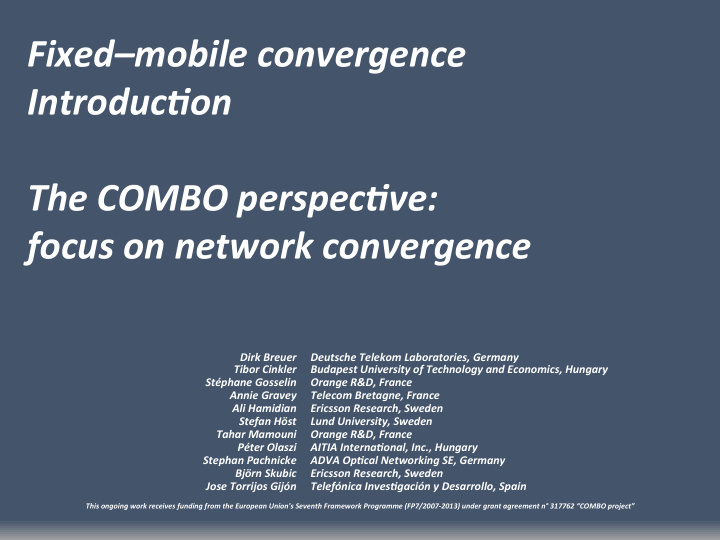



Fixed–mobile convergence IntroducSon The COMBO perspecSve: focus on network convergence Dirk Breuer Deutsche Telekom Laboratories, Germany Tibor Cinkler Budapest University of Technology and Economics, Hungary Stéphane Gosselin Orange R&D, France Annie Gravey Telecom Bretagne, France Ali Hamidian Ericsson Research, Sweden Stefan Höst Lund University, Sweden Tahar Mamouni Orange R&D, France Péter Olaszi AITIA InternaSonal, Inc., Hungary Stephan Pachnicke ADVA OpScal Networking SE, Germany Björn Skubic Ericsson Research, Sweden Jose Torrijos Gijón Telefónica InvesSgación y Desarrollo, Spain This ongoing work receives funding from the European Union's Seventh Framework Programme (FP7/2007-2013) under grant agreement n° 317762 “COMBO project”
The COMBO consorSum Operators Vendors Small and medium enterprises Academic and research institutions • CO nvergence of fixed and M obile B r O adband access/aggrega3on networks • Large scale integra3ng project • Work programme topic: ICT- 2011.1.1 Future Networks • Web page: hIp://www.ict-combo.eu
COMBO FMC: Network Convergence is in focus Today‘s network architecture Poten3al converged architecture Fixed and mobile networks – Common architecture requires – § developed independently § Structural convergence § limited joint usage of Common use of infrastructure, § technology, interfaces, transport infrastructure mechanisms § independent network opera3on, § Func3onal convergence control and management Unifica3on of fixed and mobile § § convergence only at service level network func3ons and services (e.g. IMS) Func3onal Fixed Fixed Core Fixed Aggrega3on convergence Core Fixed access Func3onal Structural access Aggrega3on convergence convergence Network Mobile Mobile Func3onal Radio Network Core Core convergence access Radio access
Why network convergence is needed Drivers Expected benefits • Increasing number of users and • Unified hardware resources – connected devices for both fixed and mobile services • Access any content any 3me • Cost and energy savings anywhere from any device • Increased revenue • Demand for video streaming – for • Improved customer experience fixed and mobile customers • Network infrastructure with • Increasing Wi-Fi traffic end-to-end management and • Tight price pressure on telcos: Reduce orchestra3on capabili3es CAPEX/OPEX, Generate new revenue, Improve user experience Broadband subscribers Traffic Connected devices increase Video contents Online services New technologies
Illustra3on of fixed and mobile traffic increase F&M German networks F&M traffic forecast Based on the real German • network topology, popula3on and Cisco’s traffic evolu3on studies Overall mobile traffic will grow • from 1.6% to 7.3% from 2012 to 2017 Average traffic in 2017 will be • 4 Gb/s at the regional PoP and 200 Gb/s at the core PoP Fixed Mobile traffic growth alone is • not a driver to change the Mobile aggrega3on network structure x20 Peak Traffic at busiest regional and core POPs
Huge variation in Today’s segmented networks Fixed and wireless terminal equipment have separated and technologies control, operation and management Simple sharing of aggregation infrastructure – no common technology base Different IP edge solutions per technology Potential for network optimization through – • Converged network control and operation → functional convergence • Converged transport for mobile and fixed network → structural convergence
Network convergence reference framework IP edge can be here or somewhere else – COMBO will assess CO Main CO Core CO Approximate numbers of several 1,000s to a few 10,000s to 1,000,000s customers per service area 10,000s ~100,000
Target benefit: Converged access and aggregaSon technologies Homes Network Element Businesses IP IP Access Backbone New access/aggrega2on Edge Node network for all services NE NE NE Individuals Mobile BBU Core Hotel Base Sta3on Objec3ve: universal access and aggrega3on technology • scaling for traffic growth • scaling for number of user equipment •
Target benefit: Universal access bundling for residenSal gateway Wi-Fi Access Point Hybrid Connec2on Homes Gateway Fixed Access Fixed Wi-Fi Network IP Edge NT (Converged) IP Backbone L3 Fixed Aggrega2on Businesses RGW NT Network Fixed Access Mobile Mobile Node IP Edge NT Radio Access Service Network Provisioning PlaLorm Base Sta3on Objec3ve: Integrated hybrid access to residen3al end-users • Dynamic bandwidth using fixed and mobile technologies • Benefits: • One authen3ca3on for the customer – not per technology More efficient network management for the operator Improved network performance and user experience
Presented by Annie Gravey annie.gravey@telecom-bretagne.eu Péter Olaszi peter.olaszi@aiSa.ai Björn Skubic bjorn.skubic@ericsson.com Dirk Breuer Deutsche Telekom Laboratories, Germany Tibor Cinkler Budapest University of Technology and Economics, Hungary Stéphane Gosselin Orange R&D, France Annie Gravey Telecom Bretagne, France Ali Hamidian Ericsson Research, Sweden Stefan Höst Lund University, Sweden Tahar Mamouni Orange R&D, France Péter Olaszi AITIA InternaSonal, Inc., Hungary Stephan Pachnicke ADVA OpScal Networking SE, Germany Björn Skubic Ericsson Research, Sweden Jose Torrijos Gijón Telefónica InvesSgación y Desarrollo, Spain This ongoing work receives funding from the European Union's Seventh Framework Programme (FP7/2007-2013) under grant agreement n° 317762 “COMBO project”
Recommend
More recommend